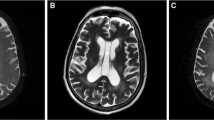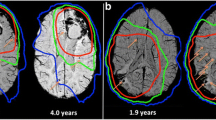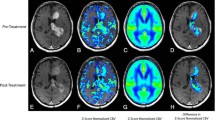Abstract
Whole brain radiation therapy (WBRT) is one of the most effective modalities for treatment of brain metastases. With increasing cancer control there is growing concern regarding the long-term effects of treatment. These effects are seen as white matter change (WMC) on brain MRI. Severity of WMC is implicated in cognitive and functional decline in many patient groups. Our objective was to identify clinical factors associated with greater accumulation of WMC following WBRT. Through retrospective review of serial MRIs obtained from 30 patients surviving greater than 1 year after WBRT, treated at a single institution between 2002 and 2007, we calculated volumetric WMC over time using segmentation software. Changes related to tumor, secondary effects, surgery or radiosurgery were excluded. Factors that influenced the rate of WMC accumulation were identified through multivariate analysis. Following WBRT, patients accumulated WMC at an average rate of 0.07% of total brain volume per month. In multivariate analyses, greater rates of accumulation were independently associated with older age (β = 0.004, p < .0001), poor levels of glycemic control (β = 0.048, p < .0001) and hypertension diagnosis (β = 0.084, p < .0001). Long-term survivors of cancer allow assessment of late effects of treatment modalities. Radiation injury appears to be related to a steady rate of white matter damage over time, as indicated by progressive accumulation of WMC. Our results suggest that rate of WMC accumulation is enhanced by parameters such as hyperglycemia and hypertension. This has significant clinical impact by clearly identifying hyperglycemia, steroid-induced hyperglycemia, and other vascular risk factors as targets for intervention to decrease WMC in patients receiving WBRT.




Similar content being viewed by others
References
Fujii O et al (2006) White matter changes on magnetic resonance imaging following whole-brain radiotherapy for brain metastases. Radiat Med 24(5):345–350
Johannesen TB et al (2003) Radiological and clinical assessment of long-term brain tumour survivors after radiotherapy. Radiother Oncol 69(2):169–176
Armstrong CL et al (2004) A critical review of the clinical effects of therapeutic irradiation damage to the brain: the roots of controversy. Neuropsychol Rev 14(1):65–86
Bazin PL et al (2007) Volumetric neuroimage analysis extensions for the MIPAV software package. J Neurosci Methods 165(1):111–121
Breteler MM et al (1994) Cognitive correlates of ventricular enlargement and cerebral white matter lesions on magnetic resonance imaging. The Rotterdam study. Stroke 25(6):1109–1115
Deary IJ et al (2006) White matter integrity and cognition in childhood and old age. Neurology 66(4):505–512
Deary IJ et al (2003) Cerebral white matter abnormalities and lifetime cognitive change: a 67-year follow-up of the Scottish mental survey of 1932. Psychol Aging 18(1):140–148
Leaper SA et al (2001) Neuropsychologic correlates of brain white matter lesions depicted on MR images: 1921 Aberdeen Birth Cohort. Radiology 221(1):51–55
Emami B et al (1991) Tolerance of normal tissue to therapeutic irradiation. Int J Radiat Oncol Biol Phys 21(1):109–122
O’Connor MM, Mayberg MR (2000) Effects of radiation on cerebral vasculature: a review. Neurosurgery 46(1):138–149 (discussion 150–1)
Schultheiss TE et al (1995) Radiation response of the central nervous system. Int J Radiat Oncol Biol Phys 31(5):1093–1112
Armstrong CL et al (2002) Late cognitive and radiographic changes related to radiotherapy: initial prospective findings. Neurology 59(1):40–48
Pantoni L et al (2002) Visual rating scales for age-related white matter changes (leukoaraiosis): can the heterogeneity be reduced? Stroke 33(12):2827–2833
Correa DD et al (2004) Cognitive functions in survivors of primary central nervous system lymphoma. Neurology 62(4):548–555
Neuwelt EA et al (2005) Imaging changes and cognitive outcome in primary CNS lymphoma after enhanced chemotherapy delivery. AJNR Am J Neuroradiol 26(2):258–265
Shan ZY et al (2006) Quantitative morphologic evaluation of white matter in survivors of childhood medulloblastoma. Magn Reson Imaging 24(8):1015–1022
van den Heuvel DM et al (2006) Measuring longitudinal white matter changes: comparison of a visual rating scale with a volumetric measurement. AJNR Am J Neuroradiol 27(4):875–878
Bastin ME et al (2009) Diffusion tensor and magnetization transfer MRI measurements of periventricular white matter hyperintensities in old age. Neurobiol Aging 30(1):125–136
Wu M et al (2006) A fully automated method for quantifying and localizing white matter hyperintensities on MR images. Psychiatry Res 148(2–3):133–142
Starr JM et al (2003) Brain white matter lesions detected by magnetic resonance [correction of resonance] imaging are associated with balance and gait speed. J Neurol Neurosurg Psychiatry 74(1):94–98
Shenkin SD et al (2005) Cognitive correlates of cerebral white matter lesions and water diffusion tensor parameters in community-dwelling older people. Cerebrovasc Dis 20(5):310–318
Reddick WE et al (2006) Smaller white-matter volumes are associated with larger deficits in attention and learning among long-term survivors of acute lymphoblastic leukemia. Cancer 106(4):941–949
O’Sullivan M et al (2001) Evidence for cortical “disconnection” as a mechanism of age-related cognitive decline. Neurology 57(4):632–638
Duckworth W et al (2009) Glucose control and vascular complications in veterans with type 2 diabetes. N Engl J Med 360(2):129–139
Murray AD et al (2005) Brain white matter hyperintensities: relative importance of vascular risk factors in nondemented elderly people. Radiology 237(1):251–257
Welzel T et al (2008) Diffusion tensor imaging screening of radiation-induced changes in the white matter after prophylactic cranial irradiation of patients with small cell lung cancer: first results of a prospective study. AJNR Am J Neuroradiol 29(2):379–383
Martini SR, Kent TA (2007) Hyperglycemia in acute ischemic stroke: a vascular perspective. J Cereb Blood Flow Metab 27(3):435–451
Gallagher KA et al (2006) Hyperbaric oxygen and bone marrow-derived endothelial progenitor cells in diabetic wound healing. Vascular 14(6):328–337
Author information
Authors and Affiliations
Corresponding author
Additional information
N. Szerlip and C. Rutter are equal contributors.
Rights and permissions
About this article
Cite this article
Szerlip, N., Rutter, C., Ram, N. et al. Factors impacting volumetric white matter changes following whole brain radiation therapy. J Neurooncol 103, 111–119 (2011). https://doi.org/10.1007/s11060-010-0358-7
Received:
Accepted:
Published:
Issue Date:
DOI: https://doi.org/10.1007/s11060-010-0358-7




